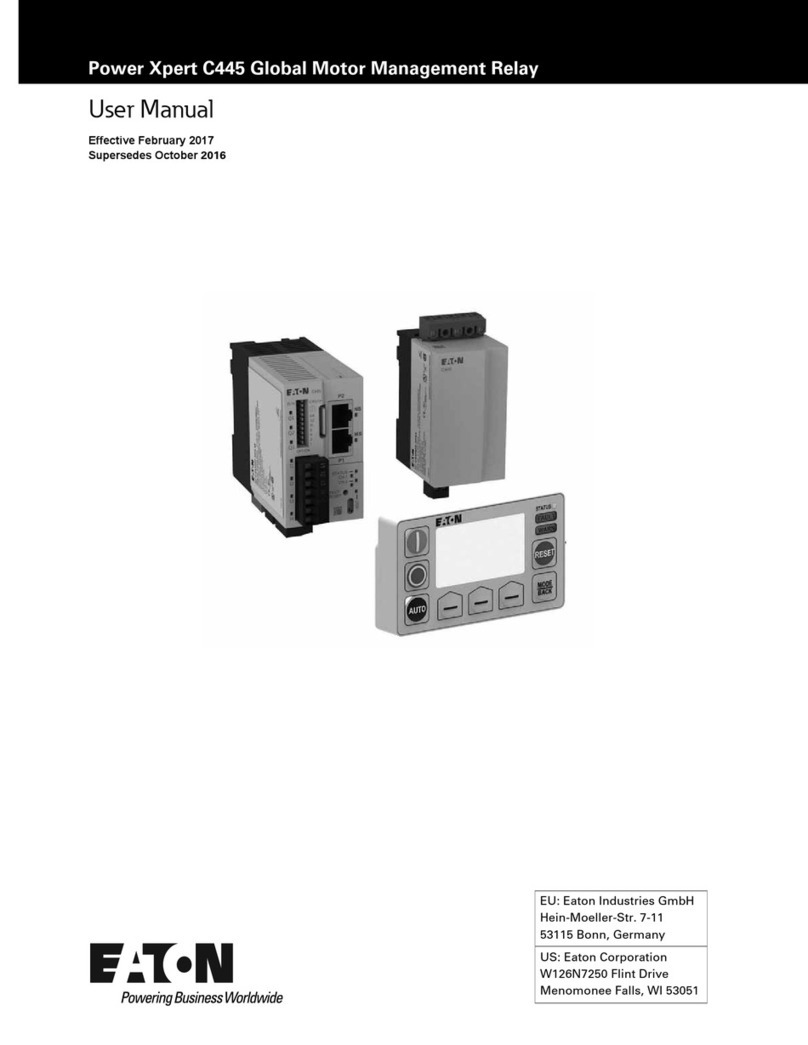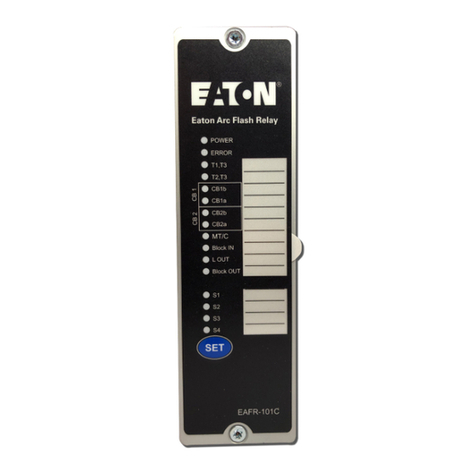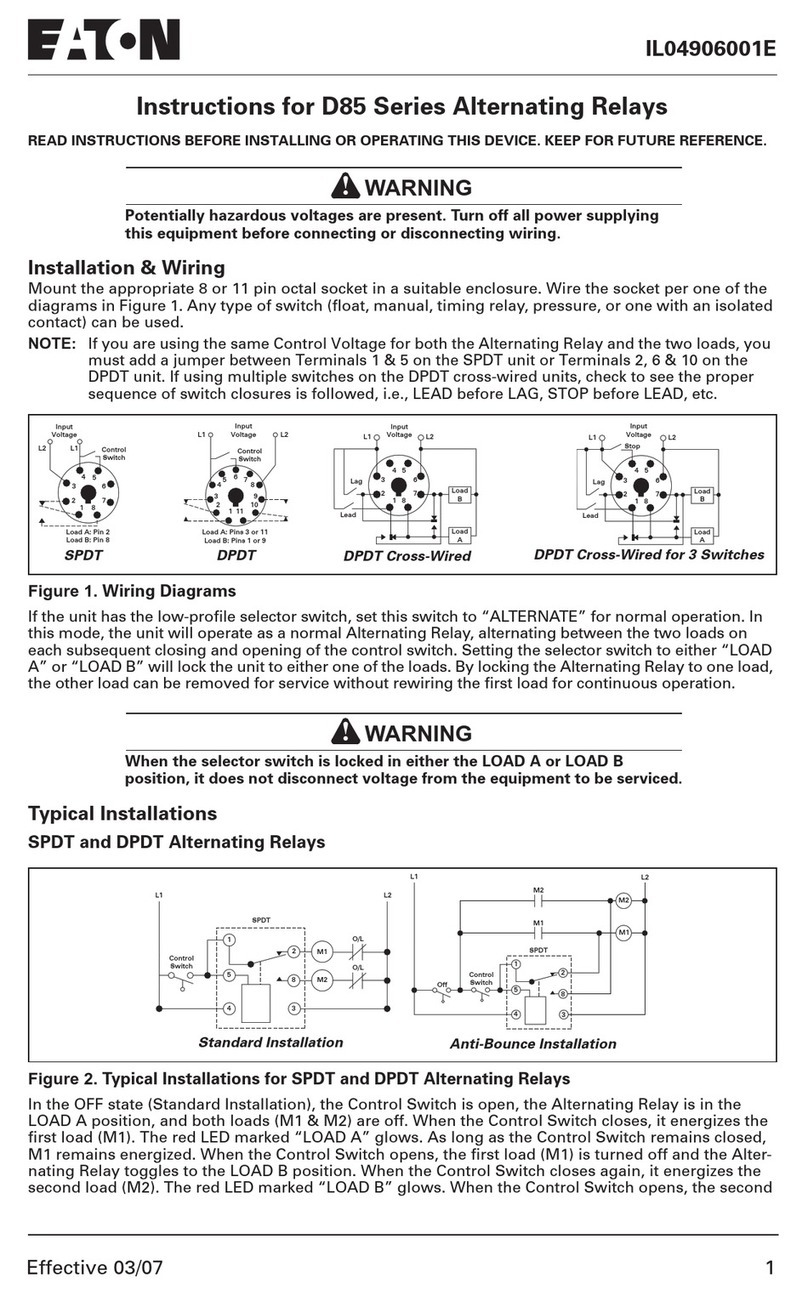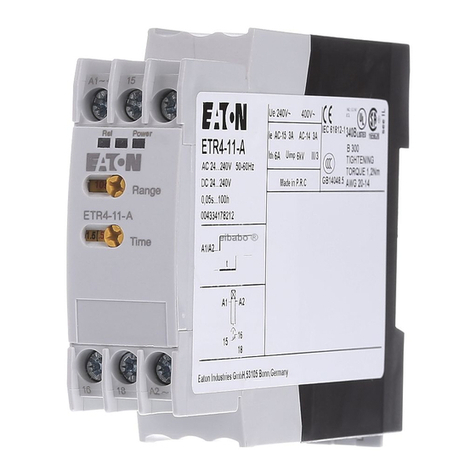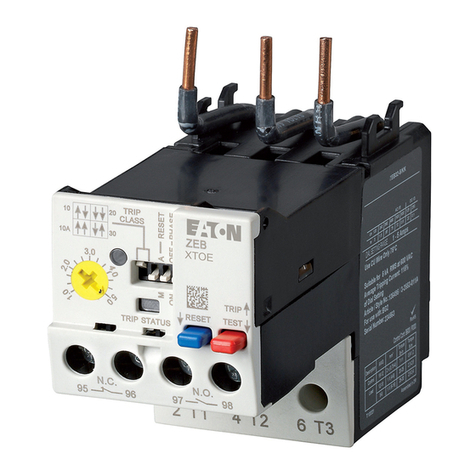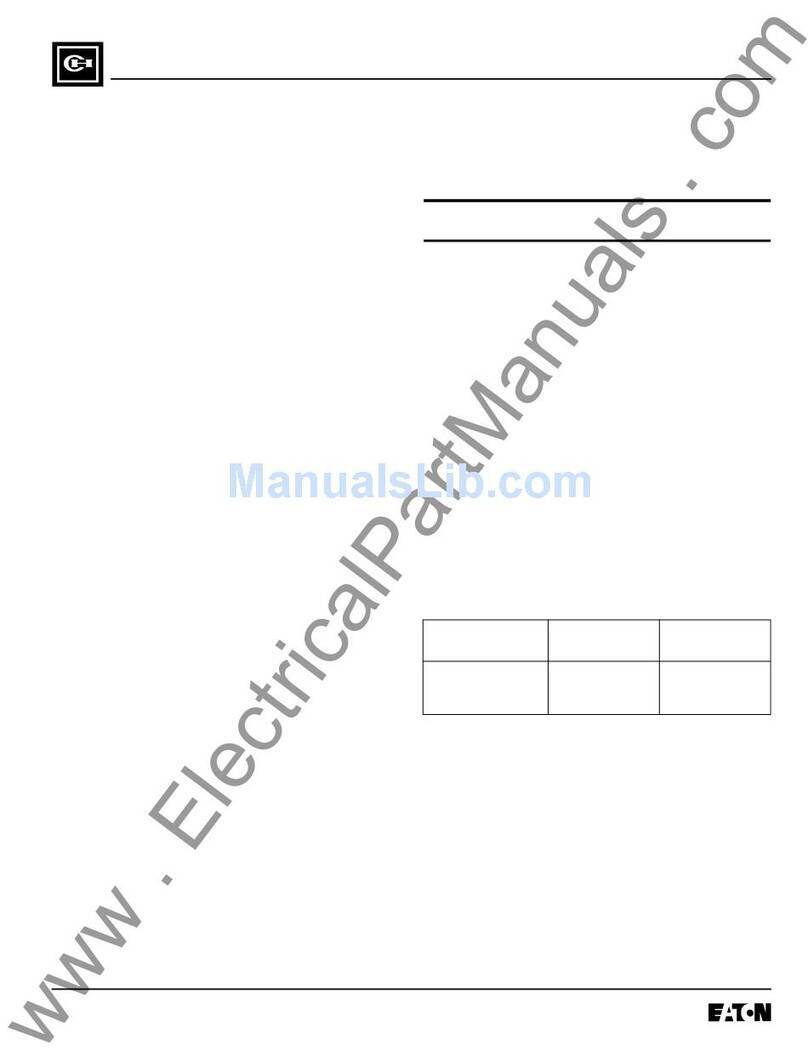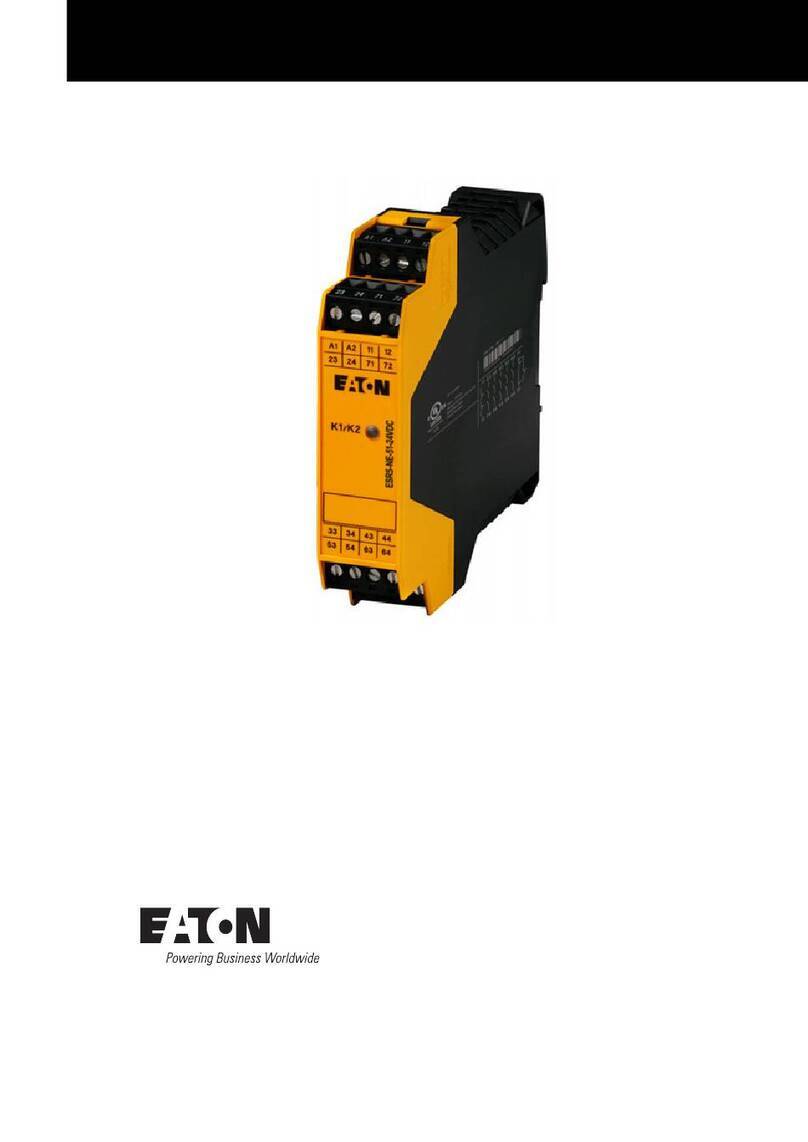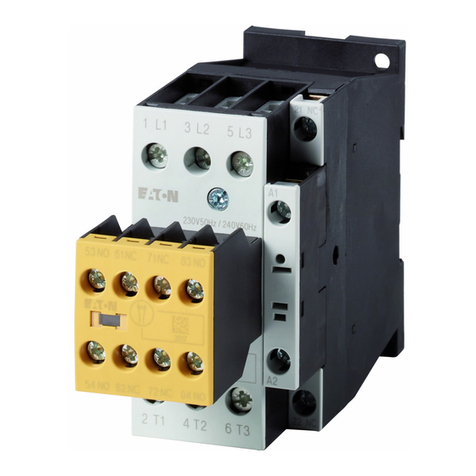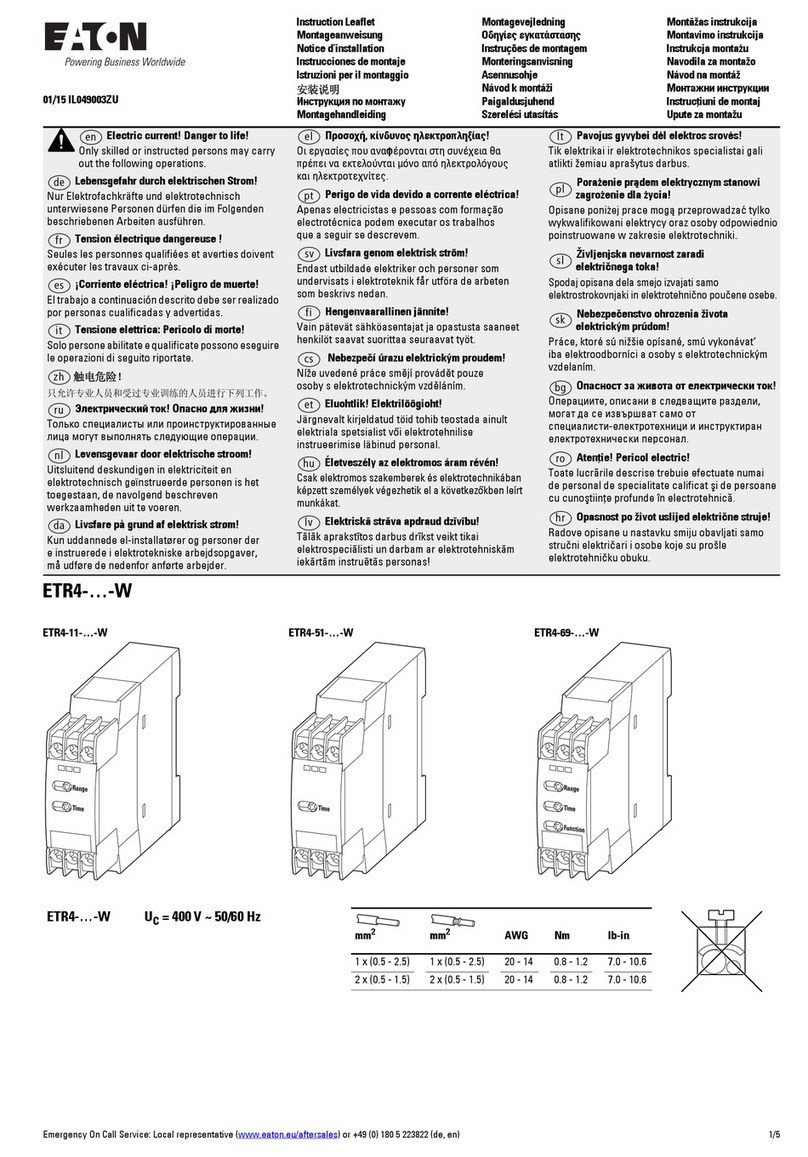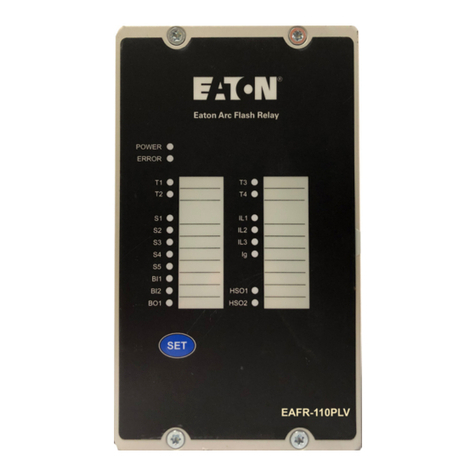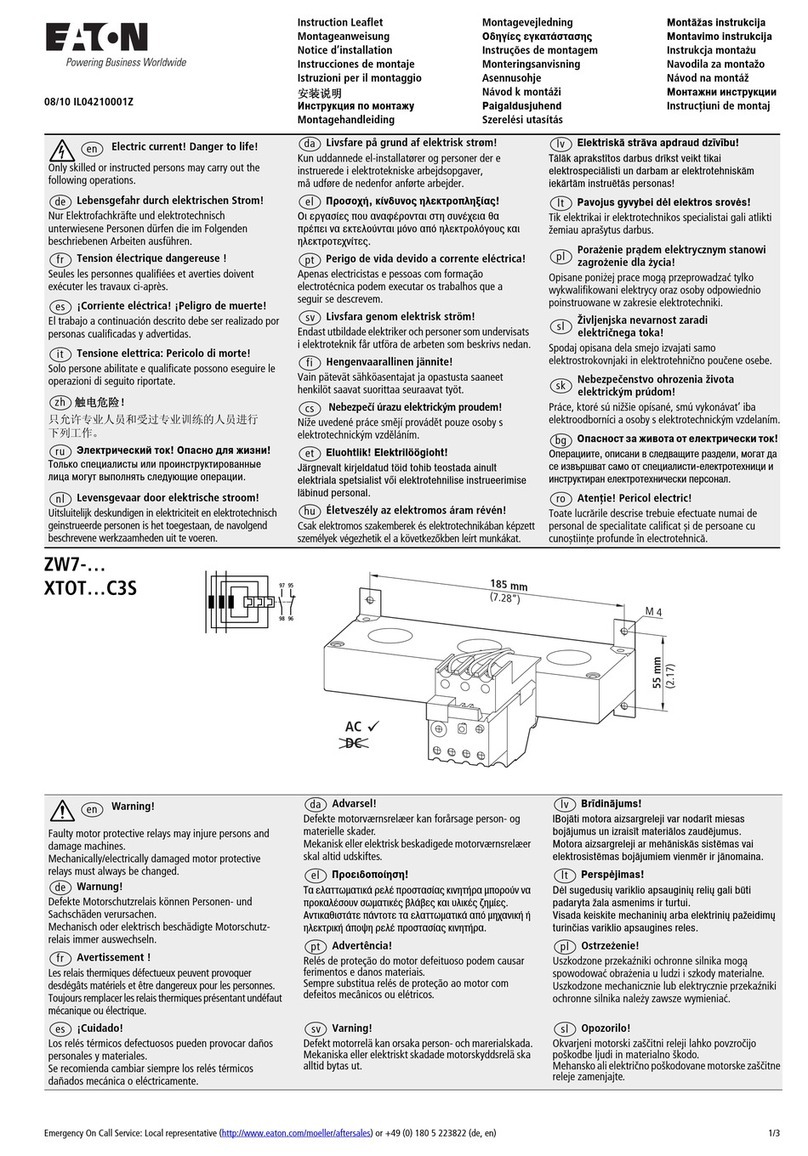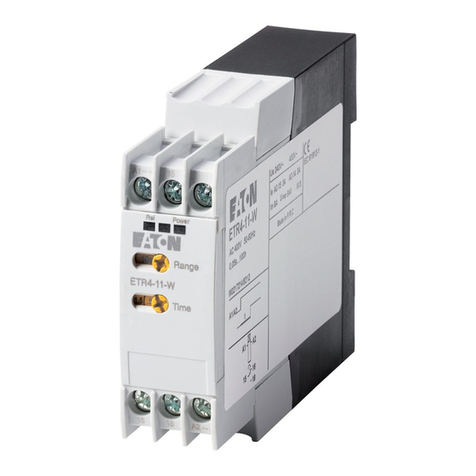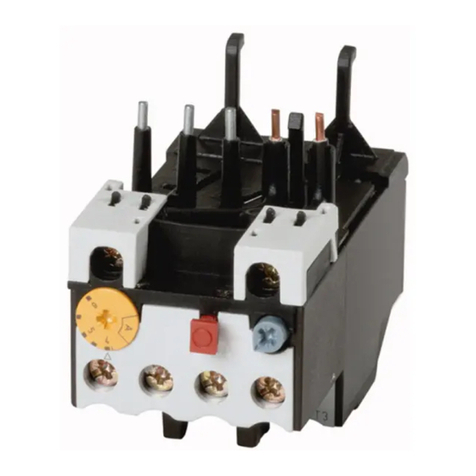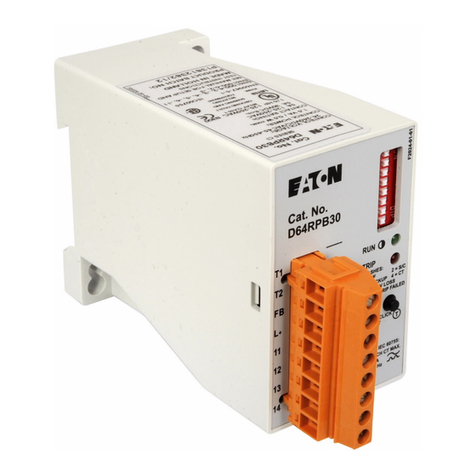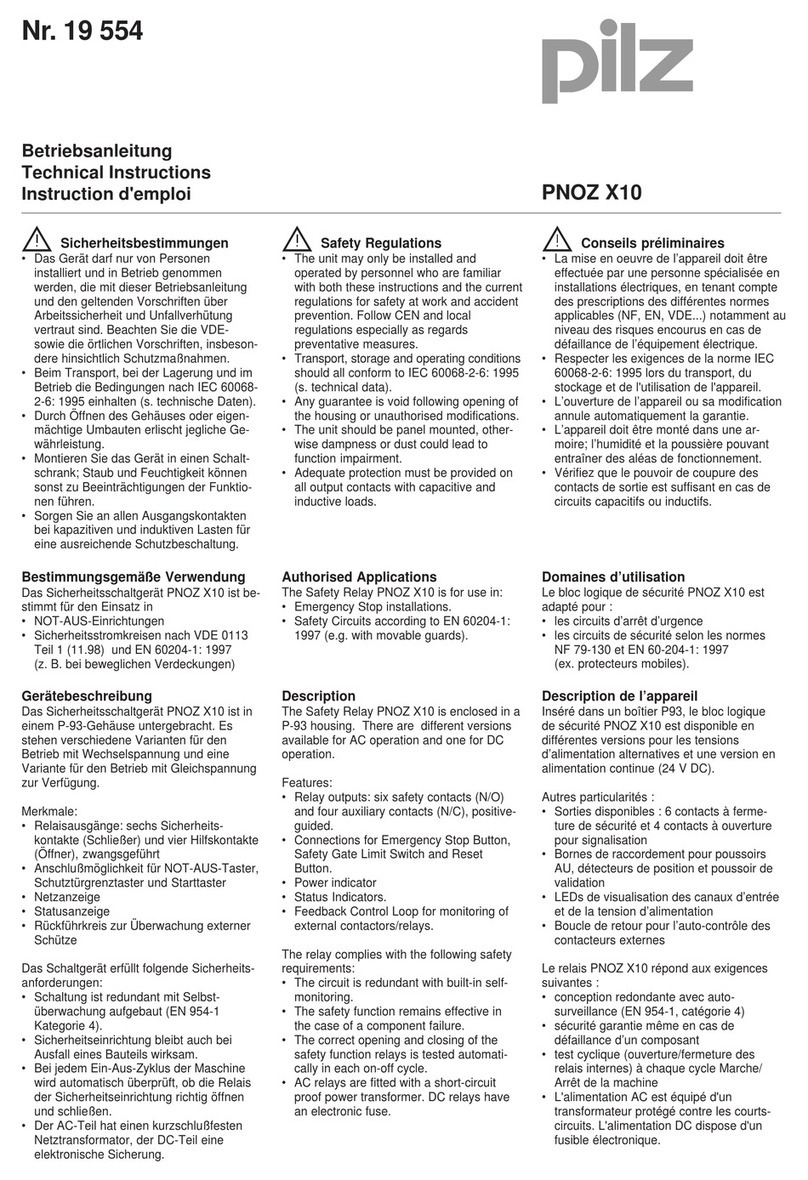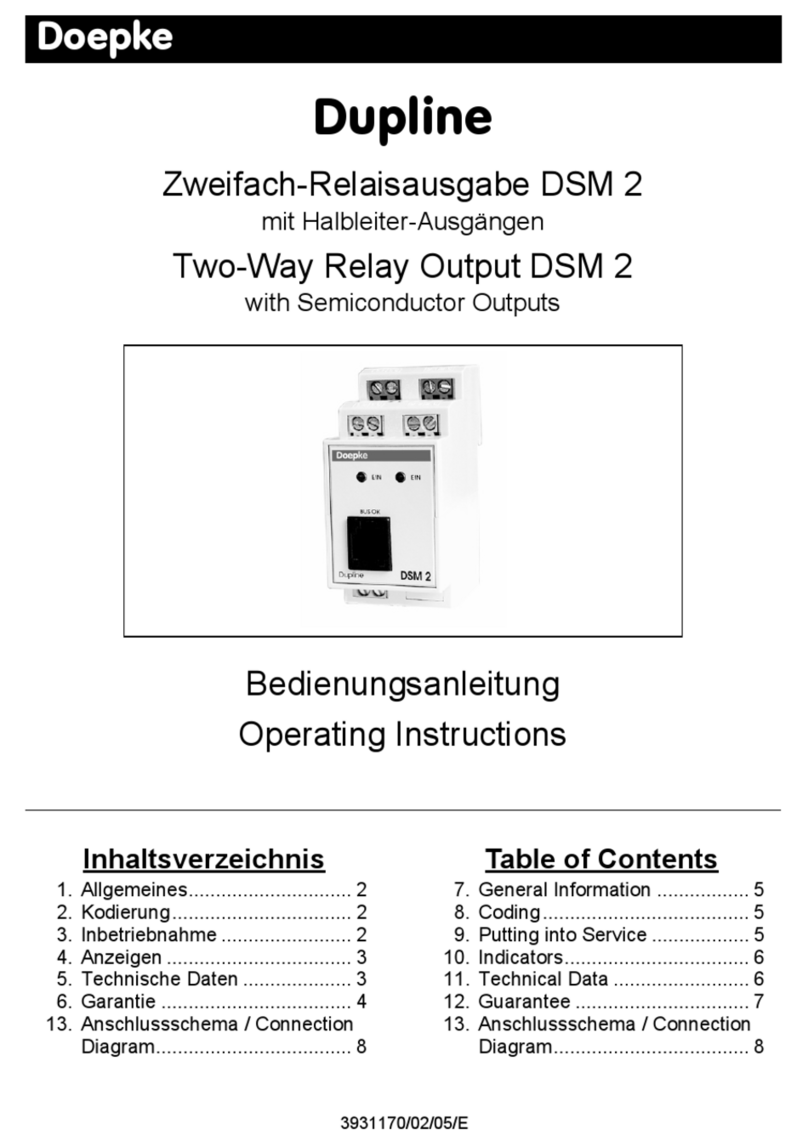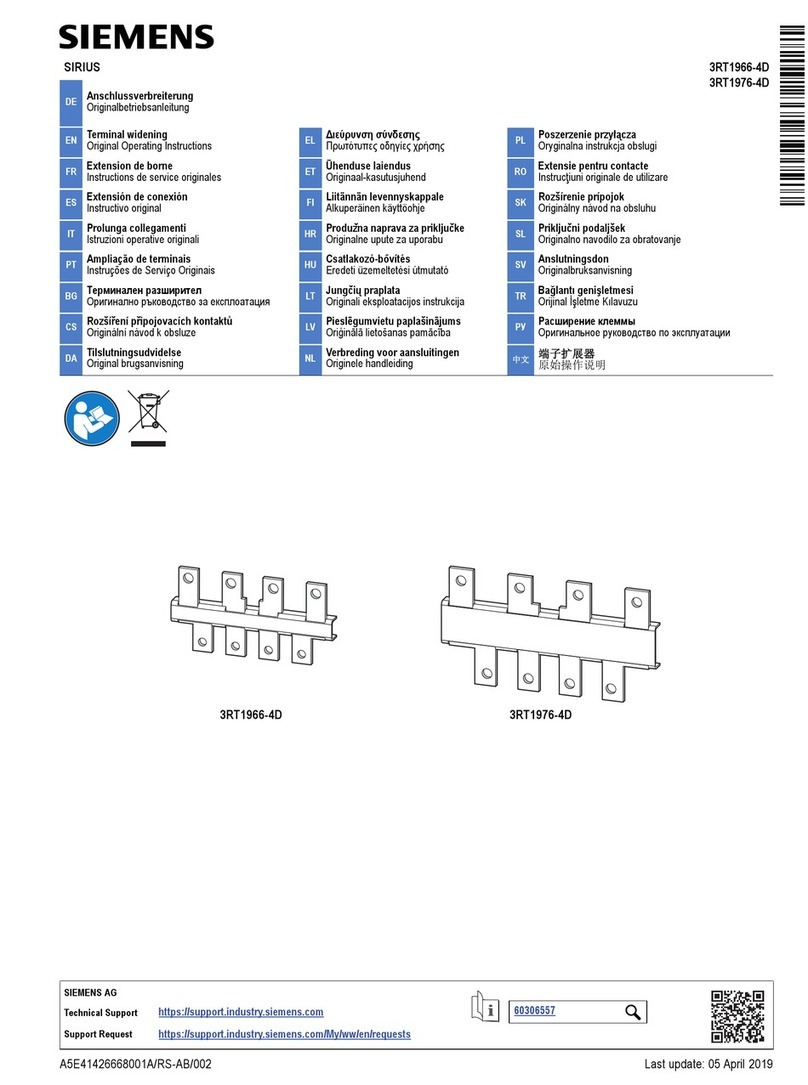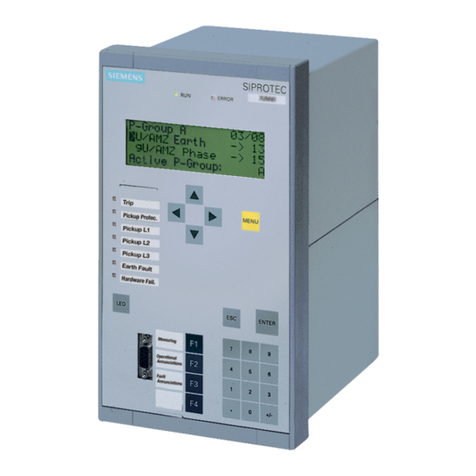
5. Electrical Data:
Rated voltage 24, 115, 230 or 400 V (Z-USA) 50 Hz
Maximum operating voltage 25, 120, 240 or 415 V (Z-USA) 50 Hz
Rated impulse withstand voltage mind. 4 kV
Power loss at rated voltage 3 VA (Z-USA), 5 VA (Z-USD)
Tripping typically at 0.4 to 0.5 x rated voltage
Switching ON possible typically at 0.7 bis 0.8 x rated voltage
Tripping delay, typically > 0.02 s Z-USA and 0.4 s Z-USD
Permissible ambient temperature -5 to +400C
6. Mechanical characteristics:
Dimensions 1 module width, compatible with ZP-A, CLS, PLS, Z-MS
Function can be used with 1p up to 3p+N (4p) switches and protective devices
Terminal capacity 1 x 1 mm² up to max. 2 x 2,5 mm² Ye and Yf with wire end sleeves
Terminal type lift terminals
Terminal screws Pozidrive No. 2 captive screw
Terminal torque min. 0.8 to max. 1 Nm
7. Applications:
- To prevent dangerous machines, conveyors, hoists, etc. from self-starting after line voltage interruption.
- To protect electrical devices and machinery from operation at relevant undervoltage.
- For monitoring of all outer conductors of a three-phase AC system the break contact of a voltage control relay may be
connected in series to the undervoltage release - see connection diagram.
- For centralized switchoff functions including emergency switch off, the use of passive (static current) tripping circuits is
recommandet by far more secure than active remote switchoff, e.g. by means of electromagnetic shunt trip release. In case
of a passive tripping circuit will only the line interruption lead to switchoff thus ruling out any danger. In case of line break, a
shunt trip release would not work any more and therefore could not activate emergency switch off.Abb. 2
8. Notes:
If despite taking into account the instructions for installation, no satisfactory result is achieved, the device may be defective
and should be forwarded to the supplier. Do not attempt to make any repairs on your own. This would invalidate our warranty.
MONTAGEANLEITUNG Unterspannungsauslöser
Z-USA und Z-USD
1. Beschreibung und Funktion:
Die Unterspannungsauslöser der Type Z-US./... sind passive, elektromagnetische Auslöserelais, die bei wesentlicher Unter-
schreitung oder Unterbrechung der Versorgungsspannung den angekoppelten Schalter oder Schutzschalter auslösen und
damit eine allpolige Abschaltung eines Verbrauchers oder Stromkreises ermöglichen. Die Abschaltung erfolgt bei der Type
Z-USA unverzögert, beim Z-USD mit Verzögerung.
DanichtnurdieUnterbrechung der Versorgungsspannung, sondernauch ihre längere,andauerndeAbsenkung zurBeschädigung
von elektronischen Geräten und elektrischen Verbrauchseinrichtungen führen kann, wird bei deutlicher Spannungsabsenkung
(typisch 0,4 bis 0,5 x Un) eine Abschaltung ausgelöst. Das Wiedereinschalten ist, vorausgesetzt mindestens 0,7 x Un stehen
zur Verfügung, also auch unterhalb der vollen Bemessungsspannung möglich.
2. Anzeige:
Eine mechanische Spannungs-Kontrollanzeige informiert mittels blau/weißem Farbwechsel, selbst bei blockiertem Einschalt-
knebel des gekoppelten Schalters über das Vorhandensein der Netzspannung.
Blau bedeutet: ausgelöst, oder keine Spannung.
Weiß bedeutet: Spannung vorhanden.
3. Montage:
DerAuslöser istgrundsätzlich von links an denzukoppelnden, in derAUS-Stellung befindlichenSchalterZP-A, Leitungsschutz-
schalter CLS, PLS oder Motorschutzschalter Z-MS heranzuführen und durch die roten Führungshülsen positioniert ganz an
dessen Seitenfläche zu drücken. Mittels der beiden im USA/USD eingesetzen Schrauben wird die mechanische Verbindung
zum Schalter hergestellt. Auf ein sorgfältiges Einführen des Koppelstiftes - ohne Gewaltanwendung - in die nierenförmige
Schalteröffnung und den im Schalter liegenden Gelenksteil ist dabei zu achten.Abb. 1
4. Servicetaste:
FürTestzwecke (Schaltungskontrolle)kannder gekoppelte Schalter auchohneanliegende Spannung am Unterspannungsaus-
löser dann eingeschaltet werden, wenn die Servicetaste betätigt wird, dabei tief und dauernd gedrückt bleibt. Beim Loslassen
gehtderAuslöserin dieAusgangslage zurück undentklinktdas gekoppelte Schaltgerät (Schaltknebelgehtin dieAUS-Position).
5. Elektrische Daten:
Bemessungsspannung 24, 115, 230 oder 400 V (Z-USA) 50 Hz
Betriebsspannung max. 25, 120, 240 oder 415 V (Z-USA) 50 Hz
Bemessungs-Stoßspannungsfestigkeit mind. 4 kV
Verlustleistung bei Bemessungsspannung 3 VA (Z-USA), 5 VA (Z-USD)
Auslösung typisch bei 0,4 bis 0,5 x Bemessungsspannung
Einschaltung möglich - typisch bei 0,7 bis 0,8 x Bemessungsspannung
Auslöseverzögerung typisch > 0,02 s bei Z-USA und ca. 0,4 s bei Z-USD
Zulässige Umgebungstemperatur -5 bis +400C
6. Mechanische Eigenschaften:
Abmessungen 1 Modul Breite, kompatibel zu A7, CLS, PLS, MS7
Funktion mit 1p bis 3p+N (4p) Schaltern und Schutzschaltern möglich
Klemmenquerschnitt 1 x 1 mm² bis max. 2 x 2,5 mm² Ye und Yf mit Aderendhülsen
Klemmentyp Liftklemmen
Klemmenschrauben Pozidrive Nr. 2, unverlierbar
Klemmendrehmoment 0,8 / 1 Nm mind. / max.
7. Anwendungen:
- Zum Verhindern von Selbstanläufen gefährlicher Maschinen und Fördereinrichtungen, wenn bei Wiederkehr der Versor-
gungsspannung durch unkontrollierten Start eventuell ein gefährlicher Betriebszustand entstehen könnte.
- Zum Schutz von Stromverbrauchseinrichtungen gegen Betrieb mit wesentlicher Unterspannung
- Zur Überwachung aller Außenleiter eines Drehstromsystems eventuell Ruhekontakt eines Spannungs-Kontrollrelais in Reihe
zum Unterspannungsauslöser - siehe Schaltbild.
- Für zentrale Ausschaltfünktionen bis hin zum NOT-AUS-Betrieb (nicht mit Z-USD) ist die Verwendung von passiven
(Ruhestrom) Auslösekreisen wesentlich sicherer als die aktive Fernabschaltung, z.B. mittels elektromagnetischer
Arbeitsstromauslöser. Eine Leitungsunterbrechung führt nur beim Passiv-Auslösekreis zur Abschaltung und daher zu keiner
Gefährdung. Ein Arbeitsstromauslöser wäre bei Leitungsbruch nicht mehr funktionsfähig und könnte die Notabschaltung
nicht auslösen. Abb. 2
8. Hinweise:
DieMontage,derAnschluss und die Inbetriebnahme diesesSchutzschaltersdarf nur durch eineautorisierteElektrofachkraft er-
folgen.Wirdtrotz Beachtung derMontagehinweise keine einwandfreieFunktiondes Gerätes erreicht,kanndieses schadhaftsein
undistan denHerstellereinzusenden. EigeneEingriffeindenSchalter sindnichtzulässig und schließenjede Gewährleistung aus!
Instructions for Mounting and Installation of the
Undervoltage Release Z-USA and Z-USD
1. Function and Description:
The undervoltage releases type Z-US./... are passive electromagnetic tripping relays which cause tripping of the connected
switch or protection switch in case of interruption or relevant downward deviation of the supply voltage. In this way the load or
circuit is switched off at all poles. Z-USA interrupts the circuit virtually without delay, the typical delay of Z-USD is approx. 0.4
s in order to prevent tripping in case of short-term interruptions.
Since electronic devices may be damaged not only by power failure but also by insufficient supply voltage over an extended
period of time, the circuit is switched off in case of a relevant voltage drop (typically to 30% of Un). Resettingis possible provided
that at least 80% of Un is available, i.e. even below the full rated voltage.
2. Indicator:
Amechanical voltage indicator provides information on the presence of the line voltage by means of blue/white colour change
even if the closing toggle of the connected switch is in OFF position.
Blue means: tripped, no voltage. White means: voltage present
3. Installation:
Connect the undervoltage release from the left of the switch ZP-A, miniature circuit breaker CLS, PLS or manual motor starter
Z-MS to which it is coupled while the respective switch is in the OFF POSITION and press it completely onto its lateral surface
positioned by the guide sleeves. Use the two screws in the USA/USD to establish the mechanical connection to the switch.
In doing so, make sure that the coupling pin is carefully introduced into the kidney-shaped switch opening and into the joint
component located inside the switch without using force. Abb. 1
4. Service button:
For testing purposes (wireing check) the coupled switch can be switched ON even without line voltage feed to the undervoltage
release if the service button remains pressed deep down permanently. When releasing the service key, the switch qutomatically
reverts to the OFF positon.
D
GB
E
INSTRUCCIONES DE MONTAJE Bobina de mínima tensión
Z-USAy Z-USD
1. Descripción y función:
Los Bobinas de mínima tensión de referencias Z-US./... son relés de disparo pasivos y electromagnéticos que
se disparan en caso de producirse un descenso considerable o un seccionamiento de la tensión de alimenta-
ción del interruptor o del interruptor protector acoplado, posibilitando así una desconexión para todos los polos
de un consumidor de energía o de un circuito eléctrico. La desconexión se lleva a cabo de modo instantáneo en
la referencia Z-USA y con retardo en la Z-USD.
Debido a que no sólo el seccionamiento de la tensión de alimentación, sino también el descenso prolongado
y continuado de la misma puede provocar el deterioro en los aparatos electrónicos y las instalaciones de
suministro, en caso de una caída de tensión considerable (típica de 0.4 a 0.5 x Un), se dispara la desconexión.
La reconexión, siempre y cuando se disponga de un mínimo de 0.7 x Un, también es posible por debajo de la
tensión asignada total.
2. Indicación:
Un indicador mecánico de control de la tensión informa mediante el cambio de color entre azul y blanco sobre
la disponibilidad de la tensión de red incluso en caso de bloqueo de la maneta de conexión del interruptor
acoplado.
Azul significa disparado o sin tensión.
Blanco significa que hay tensión.
3. Montaje:
La Bobina debe acercarse desde la izquierda hacia el interruptor ZP-A, el interruptor automático magneto-
térmico CLS, PLS o el interruptor protector de motor Z-MS que deba acoplarse, situado en la posición OFF y
presionarlo mediante los manguitos-guía rojos, posicionado totalmente en su superficie lateral. Mediante los
dos tornillos situados en USA/USD, se genera la conexión mecánica con el interruptor. Debe ponerse cuidado
en introducir con esmero la clavija de accionamiento (sin violencia) en la apertura reniforme del interruptor y en
la zona articulada del interruptor. Fig. 1
4. Tecla de servicio:
Para tareas de prueba (controles de conexión), el interruptor acoplado puede conectarse también sin tensión
adyacente en el Bobina de mínima tensión si se acciona la tecla de servicio y se mantiene presionada con
fuerza e ininterrumpidamente. Al soltarla, el Bobina vuelve a la posición inicial y desencaja el dispositivo de
conmutación acoplado (la maneta de conexión se sitúa en la posición OFF).
5. Datos eléctricos:
Tensión asignada 24, 115, 230 o 400 V (Z-USA) 50 Hz
Tensión asignada máx. 25, 120, 240 o 415 V (Z-USA) 50 Hz
Tensión asignada soportada al impulso mín. 4 kV
Disipación de potencia con tensión asignada 3 VA (Z-USA), 5 VA (Z-USD)
Disparo típico con 0.4 a 0.5 x tensión asignada
Conexión posible: típica con 0.7 a 0.8 x tensión asignada
Retraso de disparo típico > 0.02 s con Z-USA y aprox. 0.4 s a Z-USD
Temperatura ambiente admisible -5 a +400C
6. Características mecánicas:
Dimensiones 1 módulo anchura, compatible conA7, CLS, PLS, MS7
Función con 1p hasta 3p+N (4p), posible con interruptores e
interruptores protectores
Sección de bornes 1 x 1 mm² hasta un máx. de 2 x 2.5 mm² Ye y Yf
con terminales
Tipo de borne bornes de sustentación
Tornillos de apriete Pozidriv núm. 2, imperdible
Par de apriete borne 0.8 / 1 Nm mín./máx.
7. Aplicaciones:
- Para evitar el arranque automático de máquinas peligrosas y dispositivos de transporte en el caso de un
retorno de la tensión de alimentación, pues debido a un inicio incontrolado podría producirse un estado
operativo peligroso.
- Para proteger las instalaciones de suministro contra el funcionamiento con una tensión mínima considerable.
- Para controlar todas las fases principales de un sistema de corriente trifásica ante un posible contacto de
reposo de un relé de control de tensión en serie con el Bobina de mínima tensión (véase esquema).
- Para funciones de desconexión centrales, incluida la categoría de empleo de parada de emergencia (no
con Z-USD), la utilización de circuitos de disparo pasivos (intensidad de reposo) es considerablemente más
segura que la interrupción a distancia activa, p. ej. , mediante una bobina a emisión. Un seccionamiento de
la conexión provoca la desconexión y con ello, la ausencia de peligro, sólo con el circuito de disparo pasivo.
Una bobina de emisión en caso de interrupción de la conexión ya no sería apto para funcionar y no podría
disparar la desconexión de emergencia. Fig. 2
8. Notas:
El montaje, la conexión y la puesta en servicio de este dispositivo sólo deberá realizarlo personal cualificado au-
torizado. Si a pesar de tener en cuenta las instrucciones de montaje, no se consigue un funcionamiento correcto
del dispositivo, es posible que éste sea defectuoso y deberá devolverse al fabricante. Las manipulaciones del
interruptor por parte del usuario están prohibidas y anulan la garantía.
Mode d'emploi de la bobine à manque de tension
Z-USA, -USD
1. Description et fonction:
Les bobines à manque de tension de type Z-USA et Z-USD sont des dispositifs passifs de coupure à relais
électromécaniques. Elles permettent la coupure multipolaire de circuits en cas de chute de tension notoire ou de
coupure de réseau à l'aide d'interrupteurs ou de disjoncteurs associés. Le module Z-USA déclenche de façon
instantanée, alors que le déchlenchement du module Z-USD est retardé de 0,4 seconde (valeur typique), afin
d'éviter les déclenchements intempestifs relatifs à des micro-coupures.
Les coupures secteurs ne sont pas les sculcs causes de dommages d'appareils électroniques et d'installations
électriques.En effet,leursous -alimentation prolongée ouune baisse continuellede latensionà leursbornespeuvent
également être préjudiciable. Dans ces cas lors d'une chute de tension notoire (30% de U nominale), une coupure
s'impose. Le réarmement sera possible à partir d'un seuil inférieur à la tension nominale (80% de U nominale).
2. Indicateur d'ètat:
Un indicateur mécanique d'état (bleu/blanc) renseigne sur la présence de tension même en cas de blocage de la
manette solidaire de l'interrupteur.
bleu signifie: coupure ou manque de tension
blanc signifie: présence de tension
3. Montage:
L'organe déclencheur s'accouple en principe par la gauche à l'organe de coupure comme les interrupteur ZP-A,
disjoncteur CLS, PLS, ou disjoncteur moteur Z-MS. Positionner les embouts de couleur rouge face aux trous de
l'organe de coupure à accoupler. Veiller à engager avec précaution la bride d'accouplement, sans forcer, dans le
logementdel'organe decoupure.Exercer unepressionsimultanément surlesappareils àaccoupler.L'accouplement
définitif s'opérera lors du vissage des deux vis situées sur le coté de l'appareil. Abb. 1
4. Bouton de service:
Ades fins de tests (contrôle de commutations), en exercant une pression continue sur le bouton test, il est possible
de manoeuvrer l'organe de coupure, même en l'absence de tension aux bornes du dispositif manque de tension.
En relâchant la pression sur le bouton, l'appareil se retrouve automatiquement en position arrêt.
5. Caractéristiques électriques:
Tension nominale 24, 115, 230 ou 400 V (Z-USA) 50 Hz
Tension maximale 25, 120, 240 ou 415 V (Z-USA) 50 Hz
Tension assignée de tenue aux chocs mind. 4 kV
Puissance absorbéc sous tension nominale 3 VA (Z-USA), 5 VA (Z-USD)
Seuil de coupure (valeur typique) 0,4 à 0,5 x fois la tension nominale
Seuil de réenclenchement (valeur typique) 0,7 à 0,8 x fois la tension nominale
Temporisation au déclenchement (valeur typique) > 0,02 s Z-USA et 0,4 s Z-USD
Température ambiante -5 à +400C
6. Caractéristiques mécaniques:
Dimensions largeur 1 module, compatible avec ZP-A, CLS, PLS, Z-MS
Application avec interrupteurs et disjoncteurs (1P à 4P)
Capacité de raccordement 1 x 1 mm² à 2 x 2,5 mm² avec embout
Bornes de raccordement à vis
Vis de bornes de raccordement imperdables pzidriv No2
Couple de serrage 0,8 / 1 Nm min. / max.
7. Contextes d'emploi:
- Pour éviter le redémarrage de machines et de convoyeurs consécutivement à une coupure de courant.
- Pour assurer la sécurité d'installations électriques en cas de manque de tension.
- Pour assurer la surveillance des conducteurs externes d'un systéme triphasé, éventuellement le contact repos
d'un relais de surveillance de tension en série avec la bobine à manque de tension (voir figure ei-dessous).
- Pour assurer des fonctions d'arrêt centralisées et l'arrêt d'urgence, l'emploi de dispositifs de coupures passif
(à courant de repos) s'avérera plus sûr que la solution de coupure active à l'aide de bobine à émission. En cas
de coupure secteur, la coupure du circuit ne s'opérera sans prendre de risques qu'avec un dispositif de type
passif. L'emploi d'une bobine à emission ne conduirait pas, dans ce cas précis, à une coupure de l'installation
et le danger apparaîtra lors du rétablissement de la tension secteur.
- Réenclenchement de tous les interrupteurs et disjoncteurs (à l'excoption des disjoncteurs différentiels mono-
blocs) à l'aide du réenclencheur automatique avec possibilité de réenclenchement local et déporté. Abb. 2
8. Mise en garde:
Sie malgré le respect de ces instructions, le dispositif ne fonctionne pas normalement, prière de le reourner au
fournisseur. Une mauvaise manipulation ou une détérioration de l'appareil entraine l'annulation de la garantie.
F
Szerelési utasítása a Z-USA és Z-USD típusú
feszöltségcsökkenési kioldó számára
1. M
û
ködés leírása:
AZ-US./...típusúfeszültségcsökkenési kioldó passzív,elektromágneseskioldórelé amely atápfeszültségnagymér-
ték
û
csökkenése vagy teljes kiesése esetén a vele összeépítet megszakítót, véd
õ
kapcsolót kioldja. Ezzel lehet
õ
vé
tesziegyfogyasztónak vagy egy áramkörnekahálózatról való teljes lekapcsolását.AlekapcsolásaZ-USAtípusnál
gyakorlatilag késleltetés nélkül, a Z-USD típusnál kb. 0,4 s-os késlltetéssel történik, megakadályozva ezzel a rövid
feszültségkiesések okozta azonnali kikapcsolásokat.
Atápfeszültségkieséséntúl, annak hosszabb idej
û
tartóscsökkenése is azelektromosszerkezetek károsodásához
vezethet,afeszültség egyértelm
û
csökkenésekor(tipikusan az Un 30%-ra)ezértlekapcsolás történik.Avisszakap-
csolás feltétele legalább az Un 80%-nak megléte. A visszakapcsolás feltétele legalább az Un 80%-nak megléte.
A visszakapcsolás tehát a névleges feszültségnél kisebb értéken is lehetséges.
2. Jelzésadás:
Egy mechanikus mutató a kék és a fehér szín váltásával informál a tápfeszültség meglétér
õ
l, még akkor is ha a
Ki-Be kapcsoló blokkolt.
A színek jelentése: kék kioldva / nincs tápfeszültség
fehér tápfeszültség rendben
3. Szerelés:
A kioldót alapvet
õ
en balról kell összef
û
zni a felhasználni kívánt és kikapcsolt állású ZP-A-es kézi kapcsolóval, az
CLS,PLS-es kismegszakítóval vagyaz Z-MS-es motorvéd
õ
kapcsolóval.Apiros szín
û
pozicionáló hüvelyen keresztül
egészen az alapkészülék oldalfaláig kell nyomni.Az USA/USD-hez mellékelt csavarokkal lehet az alapkészülékkel
a mechanikus kötést létrehozni. Figyeljünk a összeköt
õ
stift gondos, er
õ
ltetés nélküli bevezetésére. Abb. 1
4. Szervizgomb:
Aszervizgombkapcsolási- ellen
õ
rzésifeladatokattesz lehet
õ
véazalapkészüléken akkor is, hanincstápfeszültség
a feszültségesökkenési kioldón. A szervizgomb folyamatos nyomása esetén az alapkészülék bekapcsol. Elenge-
désekor önm
û
köd
õ
en visszatér a KI állásba.
5. Elektromos adatok:
Névleges feszültség 24, 115, 230 vagy 400 V (Z-USA) 50 Hz
Max. üzemi feszültség 25, 120, 240 vagy 415 V (Z-USA) 50 Hz
Teljesítmény igény 3 VA (Z-USA), 5 VA (Z-USD)
Tipikus kioldási értékek 0,4 - 0,5 x Névleges feszültség
Tipikus bekapcsolási érték 0,7 - 0,8 x Névleges feszültség
Tipikus kikapcsolási késleltetés > 0,02 s Z-USA és 0,4 s Z-USD
Üzemi h
õ
mérséklet tartomány -5 +400C
H
1
Eaton Industries (Austria) GmbH, Eugenia 1, 3943 Schrems, Austria MA-Z-usa.indd / 06.2019f / IL019152ZU / 150501257
© 2019 by Eaton Industries (Austria) GmbH, www.eaton.eu/documentation All Rights Reserved / Printed in Austria
www.eaton.com/recycling
Instruction Leaflet
Montageanweisung
Notice d’installation
Instrucciones de montaje
Istruzioni per il montaggio
Инструкция по монтажу
Montagehandleiding
Montagevejledning
Οδηγίες εγκατάστασης
Instruções de montagem
Monteringsanvisning
Asennusohje
Návod k montáži
Paigaldusjuhend
Szerelési utasítás
Montāžas instrukcija
Montavimo instrukcija
Instrukcja montażu
Navodila za montažo
Návod na montáž
Монтажни инструкции
Instrucţiuni de montaj
Upute za montažu
Kullanma Talimatı
Инструкција за монтажу
Intruksjonsblad
Монтажна інструкція
ت ا ة
